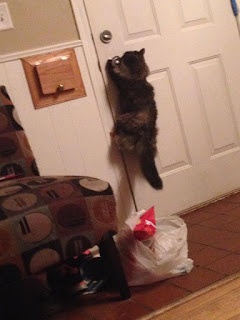If you’re like me, you never truly realize how quiet winter is until all the sounds of spring come back in a chorus of celebration. Between the birds, crickets, and frogs, you can really hear the love in the air. So you can hear the love, but can you feel the love?
Wood frogs are known for their chorus of calls that sound like a duck laughing. Seriously, tell a duck a good knock-knock joke and that is what a male wood frog sounds like when trying to attract a mate. He makes the call by expanding his two vocal sacs, membranes of skin underneath the neck, forming a bubble-like appearance. When a female surfaces, drawn to the call, the male frog clasps onto her, causing her to lay her eggs. The male frog then externally fertilizes the eggs. This form of mating is termed amplexus. The use of the call in the reproduction ritual is well studied. However, it is possible the small ripple formed in the water from the expanding vocal sack is relaying information that influences the mating behavior of these frogs.
 |
| Male wood frog resting on the water surface. Image by Maggie Nannenhorn. |
 |
| Male wood frog calling with vocal sac expanded. Notice the ripple it creates in the water. Image by Maggie Nannenhorn. |
In 2010, Gerlinde Höbel and Robb Kolodziej from the University of Wisconsin-Milwaukee conducted an experiment that explored the use of water surface waves in wood frog reproductive behavior. They hypothesized male wood frogs use ripples in the water to find female wood frogs to mate with, while female wood frogs use ripples in the water as indicators of harassing males.
Video of a wood frog calling by Maggie Nannenhorn.
Wood frogs have a very short mating period: only 1 to 3 days per year! This study occurred on April 1st - 2nd, which corresponded with the wood frogs’ natural mating period. The first component of the study was the observation of a pond containing more than 500 wood frogs in amplexus. Amplexus was determined by the presence of males clasping on to the backs of female frogs in the water. They learned males approach surface waves on the water and clasp onto the frog that caused the ripple. However, females move away from surface waves on the water and dive downward.
After preliminary observations, they developed an experiment to cause rippling of the water. The first experiment tested the effect of stimulation (dipping a wooden probe into the water) near male wood frogs. The males tested were randomly assigned to either a control group or an experimental group. The 34 males in the control group were simply observed, and the direction and pattern of movement was recorded. For the experimental group, a long wooden probe was dipped in and out of the water 25 cm away from a male frog for 10 seconds. The resulting ripple was meant to mimic a ripple caused by a female frog moving in the water. Based on the hypothesis, the male wood frogs should approach the ripple hoping to find a female to mate with. Of the 60 males in the experimental group, half were stimulated from the right and half were stimulated from the left. A circle diagram (depicted below) was used to map the direction the males moved.
Video of a wood frog approaching ripples by Gerlinde Höbel.
 |
| This figure shows: a) the control group and b) the experimental group. A circle diagram representing the reproductively driven movement direction of wood frogs (Lithobates sylvaticus) in a laboratory pool as a result of stimulated surface waves on both the left and right sides. Figure from: Höbel, G., & Kolodziej, R. C. (2013). Behaviour, 150(5), 471-483. |
The females are difficult to observe in the field since they prefer to stay beneath the surface. So, the researchers set up a tank to test 4 breeding pairs of wood frogs. They tested the females both while in amplexus and while alone. They dipped wooden probes into the water to stimulate the females on both the left and the right side in turn. Their positions and directions were also recorded using a circle diagram.
So, what did they find? It turns out, their predictions were correct! The males would approach the ripple caused by the probing. This is likely because the ripple may indicate a competing male they want to drive away or a female they want to mate with. The females moved away from the ripples by either swimming away or diving underneath the water surface. This may reduce the amount of harassment they receive from males. If a female becomes the center of attention for too many males, she may drown from the weight of them all attempting to grab her. Besides, if a male is fit, he will likely be able to catch up to her and successfully mate with her despite her swimming away.
The mating calls and movement of the wood frogs affect the surface waves, and these waves are used to make sexual behavior choices. This spring, the chorus of love will still ring out through the reeds, and I encourage you to take a moment to stop and listen. When you’re stopped, take a moment to notice the waves of love bringing these wood frogs together. Hopefully this spring, we will all be feeling the love.
Reference:
Höbel, G., & Kolodziej, R. (2013). Wood frogs (Lithobates sylvaticus) use water surface waves in their reproductive behaviour Behaviour, 1-13 DOI: 10.1163/1568539X-00003062








